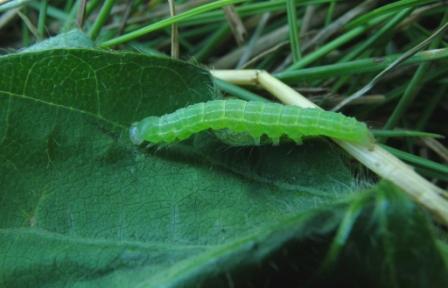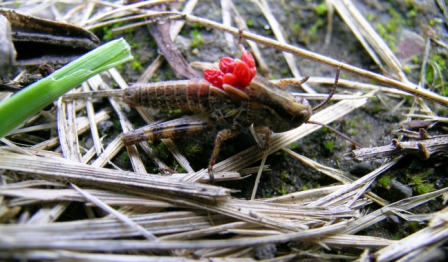Manitoba Insect and Disease Update: Week of July 29, 2013.
Pulse Crops
Defoliators on Soybeans: In some soybean fields, defoliation of leaves has been a concern. The causes vary; green cloverworm in some fields in the Interlake and Eastern Manitoba, grasshoppers in some areas, and this year there is another caterpillar (which seems to have a green and black phase) which is not one of our normal defoliators in soybeans and we are trying to rear some to figure out the species. For defoliators in soybean, generalized defoliation guidelines have been established that can be used for any of these defoliators. The following table shows what are considered the action thresholds for soybean defoliation at various stages of soybean development.
Soybean Development |
Action Threshold |
Pre-bloom (i.e. vegetative stages) |
30 - 40% |
Bloom (R1) to Pod-fill (R4) |
15-20% |
Pod-fill to maturity (R5-R6) (unless pod feeding observed) |
25% |
To accompany the table above, the following link has pictures of soybean leaves with different levels of defoliation that can be a helpful guide when assessing levels of defoliation in soybeans.
Soybeans are good at compensating for lower levels of defoliation. Note that for control to be economical the action thresholds would have to be the level of defoliation on average over the field, not just on the worst affected plants. Because our eyes are often drawn to the damage to plant tissue, rather than the healthy tissue it is easy to overestimate the level of defoliation.
A 40 percent leaf loss during any vegetative stage will result in a 3-7 percent yield reduction. Defoliation of 20 percent during the pod-forming and pod-filling stages will result in similar yield reductions.
The photo below shows a green cloverworm. Note that they have 3 pairs of prolegs in the middle of the abdomen, and 1 pair at the end of the abdomen. They will also wiggle rapidly when disturbed. There may be other green caterpillars that can occasionally occur on soybeans, so you can use these features to help distinguish them from some of these other caterpillars.

Grasshoppers on soybeans: Although they will feed on soybeans, soybeans are not a preferred host plant for our pest species of grasshoppers, and we have seen instances where they move into a soybean field but are feeding on the weeds in the field and not the soybeans. So if you do see grasshoppers in soybeans, check to see how far into the field they have moved and whether most are still near the field edge. Also check to see how much feeding they are doing to the soybeans.
Canola
Flea Beetles on podded canola: The flea beetles that we commonly see in canola have only one generation per year, yet we see the adults at two distinct times; in the spring when the adult beetles feed on crucifer seedlings, and in late-summer when the adults will feed on mature canola plants and other crucifers. The adults present in late-summer are the adults that overwinter, and will be the same adults you see next spring. This is why you see the adults twice, even though they have only 1 generation per year.
The late-summer flea beetles are starting to be noticed in some canola fields. Some have been enquiring whether populations of flea beetles can be economical on more mature canola. No specific economic thresholds are available for fall populations of flea beetles in canola, although research on this has been done at AAFC in Saskatoon. The researchers concluded that except in situations where there are extremely high populations (100’s per plant on average) feeding on plants in the very early podding stages, these populations are not likely to be economical. The biggest concern with the feeding on plants in the early-podding stage is potential increases in pod shattering and loss of seed.
Spraying for flea beetles in the fall for the purpose of reducing the risk the following spring is not recommended. Flea beetles are mobile enough that you could still have problems in the spring, as they move in from neighboring areas. In addition, there can be big differences between fall and spring populations. A strong correlation between fall and spring populations has never been established.
Bertha armyworm: Some are finding low levels of bertha armyworm larvae in canola fields, but there have been no reports of higher or economical levels of bertha armyworm larvae so far. Now is a good time to be checking for these larvae.
To look for larvae, measure an area 50cm X 50cm, which is 0.25m2. I use a 3-sided frame to define the area to be sampled. Shake the plants in the area to be sampled, just in case there are any larvae on the plants. Search on the soil for the larvae, and move earthen lumps and plant debris to expose any hidden larvae. Multiplying the number counted by 4 will give you the number per m2. A chart showing economic thresholds, and table listing potential control options, if above the economic threshold, can be found at: http://www.gov.mb.ca/agriculture/crops/insects/bertha-armyworm.html
Surveys and Forecasts
Grasshopper Survey: Manitoba, Saskatchewan and Alberta have for many years surveyed grasshopper populations in August to predict the regional risk from grasshoppers the following year. The data is mapped, and this forecast is used by farmers, agronomists, and agricultural retailers to plan for the following season.
A reminder to farm production advisors and those involved in this survey, that counts are done during August, when the majority of grasshoppers are in the adult stage. Agronomists and farmers who would also be interested in estimating grasshopper numbers in the fields they are in and have this information included in the survey are encouraged to see the survey protocol for more details of the survey and where to send data. Estimates of grasshopper levels can be collected during regular farm visits. The grasshopper survey protocol is located at: Province of Manitoba | agriculture - Manitoba Grasshopper Survey Protocol (gov.mb.ca)
Insect Identification Quiz
Question: A couple of people have commented on or sent photos of grasshoppers with red "egg-shaped" objects quite visible on their back, as seen in the photo below. What mite these red things be on the back of the grasshopper? Note - there is a hint in the way my question is posed.

Answer: These are red velvet mites. The immature stages of these mites are parasitic on grasshoppers and other insects. The adults prey on insect eggs and other small arthropods.
Compiled by:
- John Gavloski, Entomologist
Manitoba Agriculture, Food and Rural Initiatives
Phone: (204) 745-5668
Fax: (204) 745-5690. - Holly Derksen, Plant Pathologist
Manitoba Agriculture, Food and Rural Initiatives
Phone: (204) 750-4248
Fax: (204) 745-5690
To report observations on insects or plant pathogens that may be of interest or importance to farmers and agronomists in Manitoba, please send messages to the above contact address.
To be placed on an E-mail list so you will be notified immediately when new Manitoba Insect and Disease Updates are posted, please contact John Gavloski at the address or numbers listed above.
